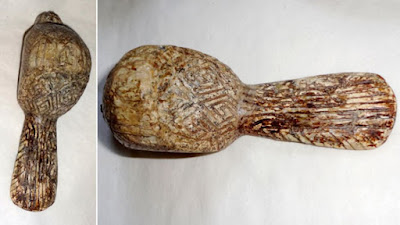Swastika: A Stolen Symbol
The swastika is a well-known Nazi symbol, but it wasn't always this way. Before the Nazi's stole and perverted this symbol it had numerous meanings in many different cultures, but the heart of most of these was peace and well-being.
Early Appearances
The swastika has been a holy symbol in Hinduism, Jainism, and Buddhism for centuries. But, it was also found on tombs from early Christians. Considering its long history, dating back over 15,000 years, this isn't surprising. Swastika's were first seen in designs similar to the image below.
The image above is from the National Museum of the History of Ukraine. This small ivory figure is of a female bird and is made from a mammoth tusk. It was found in 1908 at the Palaeolithic settlement of Mezin , near the Ukrainian-Russian border. Although it may be difficult to see in this photo, the figurine is engraved with an intricate, meandering pattern of joined up swastika's.
Swastika's as a single image date back about 7,000 years.
Hinduism
 |
| On the left is the Nazi hakenkreuz (what we often think of when we hear swastika) and the Hindu swastika. Image credit: Hindu's for Human Rights |
The word 'swastika' itself has roots in Sanskirt:
su = good
asti = to prevail
This meant wellbeing, prosperity, or good fortune. It was used in the Rig Veda prayers, the oldest Hindu scriptures.
In Hindu philosophy, the swastika represented various good things that came in fours, such as the four yugas, aims/objectives of life, stages of life, the Vedas, etc. In some parts of India, it's even a girls name.
It is displayed at weddings, festive occasions, to consecrate a new home, when starting a new venture, etc.
It also represents the fourth state of consciousness which is "beyond waking, sleeping and dreaming."
The symbol is also a symbol of the sun god when it has a clockwise rotation.
Buddhism and Jainism
 |
| Image Credit: Lion's Roar |
Known as manji in Japanese, the swastika represents the Buddha's footsteps. In Jainism it represents a spiritual teacher.
Other countries/cultures it was found in
 |
| Image Credit: BBC |
Due to its peaceful origins and meaning, the swastika inspired groups and cultures right up until Hitler started using it. So the following is a brief list.
1. Greece - found on ancient pots and vases
2. Druids and Celts- called the tetraskelion it appears on numerous artefacts. However, it was much less common than the triskele, indicating the triskele was more important in Celtic culture.
3. Norse - represented Thor's hammer
4. Ukraine - The National Museum of Ukraine has many artefacts with the symbol. The oldest they house is an ivory figurine of a bird made from a mammoth tusk from the Palaeolithic era discussed above. Discovered in 1908, it was carbon dated to 15,000 years ago.
5. Pakistan - Mohenjo-Daro and Harappan ruins
6. Europe - In the early 20th Century, it was used in Europe as a symbol of good luck.
7. Denmark - From 1881 to the 1930s, Carlberg, a Danish brewing company, used it as their logo. Until the Nazi's started using it.
8. Navajo - they used a right-facing swastika as a symbol of friendship. They stopped using it after the Second World War.
9. United States Of America- Coca-Cola and the Boy Scouts used it and the Girls' Club of America called their magazine Swastika. The girls could even get a swastika badge as a prize for selling copies of the magazine.
10. Russia - Russian author Pavel Kutenkov identified almost 200 swastika variations across the region.
Why would Hitler use it?
When searching for a symbol for his new party, Hitler used the hakenkreuz, or hooked cross. This has become the swastika we are more familiar with today. In 1933, Hitler's minister of propaganda, Joseph Goebbels passed a law preventing unauthorized commercial use of the symbol.
 |
| Nazi hakenkreuz. Image Credit: Wikipedia |
Like many cultures, the swastika has history in the area of modern-day Germany. According to the BBC:
"It has been suggested that Hitler's adaptation of the symbol may have had its roots in Germans finding similarity between their language and Sanskrit, and drawing a conclusion that Indians and Germans came from the same "pure" Aryan ancestry and linage."
In 1871, German archaeologist Heinrich Schliemann found 1,800 variations of the hooked cross (rotated swastika) on pottery fragments on an ancient Troy dig site which were similar to those found in Germany. For the Nazi's, this was proof the sites original inhabitants had been Aryan.
German Orientalist Max Muller wrote to Schliemann to warn him against using the word "swastika" for the hooked cross on the pottery from Troy. Muller knew the word had origins in Sanskrit and a specific meaning in India:
"Swastika is a word of Indian origin, and has its history and definite meaning in India. I know the temptation is great to transfer names, with which we are familiar, to similar objects which come before us. . . the occurrence of such crosses in different parts of the world may or may not point to a common origin."
Dr. Daniel Rancour-Laferriere, an expert in Christianity, suggested in his book, The Sign of the Cross: From Golgotha to Genocide, that Hitler used the hakenkreuz as his party symbol because he was brought up at the Benedictine Monastery in Austria where he would have seen it many times.
Post Hitler
Although Hitler's use of the symbol only covers a very brief period in its history, it was an extremely dark chapter.
In many European countries, including Germany, publicly displaying any Nazi symbol is a criminal offence.
In 2021, Todd Kaminsky, a New York State Senator in the United States, introduced a bill that would require New York state schools to teach that the swastika is an example of a hate symbol. Numerous organizations opposed the bill. One of the main ones was the World Hindu Council of America. This Council urged the New York Senate to differentiate between the original swastika and the Nazi hakencreuz. The Council's Director of Advocacy, Utsav Chakrabarty acknowledged the recent history of the symbol but stated "Instead of censoring the symbol, we must celebrate the positive history of it."
In 2008, the Second Hindu Jewish Leadership Summit in Jerusalem declared the following:
"A distorted version of this symbol was misappropriated by the Third Reich in Germany, and abused as an emblem under which heinous crimes were perpetrated against humanity, particularly the Jewish people. The participants recognise that this symbol is, and has been, sacred to Hindus for millennia before its misappropriation."
There have been attempts to restore the swastika to its original meaning. Obviously, this is harder in countries where Hinduism and Buddhism are not prominent religions. One example of this, would be Jewish artist Edith Altman. In 1993, Altman, who lost her grandparents in the Holocaust, created the installation Reclaiming the Symbol: The Art of Memory. In this installation, she painted a gold swastika above a black Nazi one painted on the floor. Her goal is to neutralize the swastika so no one would feel like they had to fear it anymore.
Efforts like this are not always successful. In 2020, Simran Tatuskar, a 21 year old Indian student in the United States, faced social media backlash after she tried to portray the symbol as one of peace that should be included in the school syllabus. One tweet directed at her said "In Nazi Germany, one of the first things anti-Semites did was erase the history and persecution of the Jews, minimise their struggles and appropriate their beings. By normalising the swastika, this is repeating that vicious cycle." She ended up apologizing and had to clarify her position.
In 2021, before hosting the Olympic Games, Japan removed the manji symbol for temples on tourist maps.
Understandably, the idea of neutralizing or promoting the swastika's original meaning is not easy for many people. Freddie Knoller, who experienced fascism, summarizes this feeling very well - "For the people who went through the Holocaust, we will always remember what the swastika was like in our life - a symbol of pure evil."
Sunder, Kalpana. "How an auspicious sacred sign was twisted to become the graphic embodiment of hate and intolerance. Kalpana Sunder explores the extraordinary history of a potent emblem." BBC. August 16, 2021. https://www.bbc.com/culture/article/20210816-the-ancient-symbol-that-was-hijacked-by-evil
MacGonagle, Brendan. "The Tetraskelion/Swastika in Iron Age Celtic Culture." Academia.edu. https://www.academia.edu/15170255/THE_TETRASKELION_SWASTIKA_IN_IRON_AGE_CELTIC_CULTURE
Campion, Mukti Jain. "How the world loved the swastika - until Hitler stole it. BBC. October 23, 2014. https://www.bbc.com/news/magazine-29644591



Comments
Post a Comment